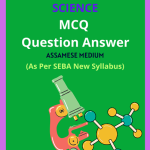Class 8 Science MCQ Chapter 11 Force and Pressure Solutions in English Medium, Class 8 Science Multiple Choice Question Answer in English to each chapter is provided in the list so that you can easily browse throughout different chapters Class 8 Science MCQ Chapter 11 Force and Pressure Notes and select need one.
Class 8 Science MCQ Chapter 11 Force and Pressure
Also, you can read the SCERT book online in these sections Class 8 Science Objective Type Solutions by Expert Teachers as per SCERT (CBSE) Book guidelines. These solutions are part of SCERT All Subject Solutions. Here we have given Assam Class 8 Science MCQs Solutions in English for All Subject, You can practice these here.
Force and Pressure
Chapter – 11
| MCQ |
1. Leaves fall down on the ground due to:
(a) electrostatic force.
(b) magnetic force.
(c) gravitational force.
(d) muscular force.
Ans: (c) gravitational force.
2. When the hammer strikes the gong of an electric bell, which of the following force is responsible for the movement of hammer?
(a) Gravitational force alone.
(b) Magnetic force alone.
(c) Electrostatic force alone.
(d) Frictional force alone.
Ans: (c) Electrostatic force alone.
3. Which one of the following forces is a contact force?
(a) Force of gravity.
(b) Magnetic force.
(c) Force of friction.
(d) Electrostatic force.
Ans: (c) Force of friction.
4. What is force?
(a) A push or pull.
(b) A type of energy.
(c) A measure of temperature.
(d) A unit of speed.
Ans: (a) A push or pull.
5. Which unit is used to measure force in the International System of Units (SI)?
(a) Newton.
(b) Joule.
(c) Pascal.
(d) Watt.
Ans: (a) Newton.
6. Pressure is defined as:
(a) Force per unit area.
(b) Mass per unit volume.
(c) Energy per unit time.
(d) Volume per unit mass.
Ans: (a) Force per unit area.
7. What is the SI unit of pressure?
(a) Newton per square meter.
(b) Joule.
(c) Meter per second.
(d) Kilogram.
Ans: (a) Newton per square meter.
8. If a force of 10 N is applied to an area of 2 m², what is the pressure?
(a) 5 Pa.
(b) 20 Pa.
(c) 10 Pa.
(d) 2 Pa.
Ans: (a) 5 Pa.
9. What does Pascal’s principle state?
(a) Pressure applied to an enclosed fluid is transmitted equally in all directions.
(b) Force is equal to mass times acceleration.
(c) Energy cannot be created or destroyed.
(d) Pressure is inversely proportional to volume.
Ans: (a) Pressure applied to an enclosed fluid is transmitted equally in all directions.
10. What is the formula for calculating pressure?
(a) Pressure = Force × Area.
(b) Pressure = Force / Area.
(c) Pressure = Area / Force.
(c) Pressure = Mass × Acceleration.
Ans: (b) Pressure = Force / Area.
11. Which of the following is an example of a contact force?
(a) Gravitational force.
(b) Magnetic force.
(c) Frictional force.
(d) Electrostatic force.
Ans: (c) Frictional force.
12. What kind of force is gravity?
(a) Contact force.
(b) Non-contact force.
(c) Applied force.
(d) Tension force.
Ans: (b) Non-contact force.
13. In which direction does atmospheric pressure act?
(a) Downwards only.
(b) Upwards only.
(c) Sideways only.
(d) All directions.
Ans: (d) All directions.
14. If the area of contact is increased while keeping the force constant, what happens to the pressure?
(a) Increases.
(b) Decreases.
(c) Remains the same.
(d) Becomes zero.
Ans: (b) Decreases.
15. Which of the following statements about pressure is true?
(a) Pressure increases with increasing area.
(b) Pressure decreases with increasing force.
(c) Pressure is independent of area.
(d) Pressure increases with increasing force.
Ans: (d) Pressure increases with increasing force.

Hi! my Name is Parimal Roy. I have completed my Bachelor’s degree in Philosophy (B.A.) from Silapathar General College. Currently, I am working as an HR Manager at Dev Library. It is a website that provides study materials for students from Class 3 to 12, including SCERT and NCERT notes. It also offers resources for BA, B.Com, B.Sc, and Computer Science, along with postgraduate notes. Besides study materials, the website has novels, eBooks, health and finance articles, biographies, quotes, and more.




